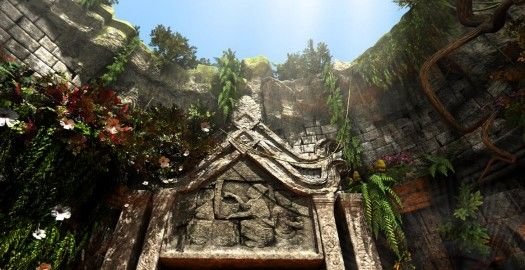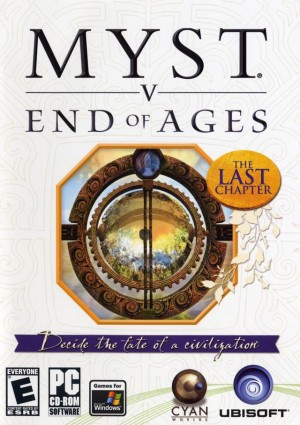Review for The Fall Trilogy: Chapter 1 - Separation

Kheops Studio has been one of the more consistent adventure game developers in recent years, yet even they are now starting to feel the lure of casual downloadable content. The French studio’s latest offering is Separation, the first in a series of three episodic games that comprise The Fall Trilogy. The premise is simply that you wake up in a mysterious temple after a fall that leaves you unable to remember what happened before. As the unnamed explorer, you must navigate the temple and overcome its various obstacles in order to escape. While somewhat similar in style to the developer’s earlier Safecracker, however, it is worth noting that along with the many puzzles to be solved, there are also numerous hidden object screens, which may deter dedicated adventurers but should appeal to casual game fans.
The game starts with little explanation of how you got where you are. There is a dark screen with tumbling rocks around you, as if you are plummeting down a giant hole, and then you revive in the Asian-themed temple, where you are greeted with a short tutorial. After being guided through a few simple tasks, you are then free to explore, but you can usually only progress to the next room after you’ve worked out how to get past a barrier like locked gates or wide chasms. After each new location is visited, it will appear on a map that can be accessed by clicking on the compass at the bottom of the screen, and a mark will appear next to each puzzle you’ve completed. These areas often need to be revisited in order to complete puzzles at a later stage in the game, though the map is just used to track your progress and help you orient yourself.
Throughout your travels, you are the only character present, seeing the game through the protagonist’s eyes. You never see this man, and don’t even learn his name, but at certain points fragments of his memory will return and more is revealed about the past through his narration. At first it may seem the sole aim is to escape from the temple and that there is little more to the plot than that. The end of this episode, however, suggests there is more to the story than meets the eye. Without giving too much away, I’ll just say it has the distinctly surreal feel of the TV show Lost, with hints of a deeper adventure that goes well beyond ancient temples and certainly raised my interest in the next instalment.
To reach that point, you’ll first need to collect objects and sometimes combine them to unlock a door or solve a problem, and you’ll also encounter some hidden object minigames. Rather than seeking a list of random objects, here you’ll be scavenging for a set of up to twenty parts of the same item, to be used in some capacity for a puzzle once completed. These scenarios can at times be childishly simple and other times frustrating when you can’t find the final piece of a broken pot or the last missing cog. The items are confined to one room, and sometimes even a single screen, and the game won’t progress until you’ve found the full amount. While many are fairly visible, others are tucked behind leaves or camouflaged in the architecture, and finding stone tiles nestled in the stony walls can be just as difficult as it sounds. You’ll never get too bogged down, however, as hints are available through a rechargeable button, which points out any object that stubbornly remains undiscovered.
Some may find these screens too easy, pointless or just boring, though casual gamers should feel right at home with such activities. I found them a little tedious, as it felt like an unnecessary step just to reach a more complex and interesting puzzle. What's worse is that the game does nothing to conceal their contrived nature, since the items don’t even exist until you need them, with no explanation given for their sudden appearance. There are also a number of ‘pairs’ puzzles that have you matching various symbols or objects with their counterparts, which isn't quite as dull as trying to find unlikely quantities of the same item. All told, perhaps as much as a quarter of your puzzle time will be spent on such tasks, so it’s not insignificant, but nor should it prove overwhelming.
The more traditional adventure puzzles are well designed, with logic that is clear from the outset. One good example challenges you to work out how much a statue weighs in rocks and sand in order to replace it, while another requires the correct alignment of cogs in order to turn a bridge. While the majority of these puzzles are self-contained, it is worth paying attention to details along the way, as one of the later puzzles is a lot easier if you’ve been taking notes. These kinds of puzzles have a good balance of difficulty, though the challenge is mitigated by the fact that there are so many clues available. Like the hint feature, a clue gauge, when charged, reveals tips to problematic puzzles when clicked in the task menu. The puzzles can even be skipped entirely, though the clues should help prevent the need. There are no penalties for skipping puzzles or using hints, though they are recorded at game’s end and you’re encouraged to play the game again to get a better score.
The point-and-click controls in Separation are simple, as footsteps appear over exit hotspots in any direction that can be explored. Most scenes offer free 360-degree camera panning, which can be controlled either by using the arrow keys or by right-clicking and rotating the view. Both methods work well and the panning moves smoothly at a good speed. Alternatively, smooth-scrolling can be turned off and the view rotated in fixed increments by clicking arrows at the edges of the screen, which is a helpful option for those bothered by motion sickness. Objects that can be picked up or interacted with are indicated by cursor changes, and when a useful item is collected it’s added to the inventory for later use.
The graphics in Separation are stunning, easily representing one of the best parts of the game. Backgrounds are beautifully rendered, highlighting the inspired temple architecture, with its high-walled rooms and Indian deity statues, and there are other nice touches as well, like a lovely flowing waterfall. Unfortunately, the inventory bar at the bottom of the screen takes up too much space, and it’s a shame it wasn’t made smaller or hidden when not in use. Water and fire animations help bring the surroundings to life, as does falling foliage, further contributing to an impressive looking game for such a small download.
The audio is also of a high quality, with short pieces of adventurous orchestral music playing at the more dramatic moments in the game. There is some spoken dialogue during the memory sequences, and when the anonymous protagonist remarks on various obstacles. The character’s voice suits the situation, displaying enough mild confusion to give the impression of someone with amnesia, though the comments he makes when operating certain puzzles can become repetitive.
There is no option to save the game manually, as this is done automatically when you exit, but experienced adventure gamers should be able to complete this instalment without (much) help in about five hours. For most of the game, I was wondering how Kheops was going to stretch this thin premise into three episodes, but the unexpected and intriguing ending nicely sets the story up for more to come.
Overall, I largely enjoyed this first episode, as the many logic puzzles are generally challenging but fun, and the temple is lovely to look at and interesting to explore. What detracts from this debut are the number of hidden object exercises, which feel too much like arbitrary filler that delay getting to the more interesting parts. They’re certainly tolerable, especially with the user-friendly hint system, and if you like these kinds of minigames, all the better, but they’re nevertheless the weakest part of an otherwise solid adventure game. This caveat aside, however, Separation is an entertaining little game, and though a bit more casual than I’d have preferred, I look forward to playing the next instalment of The Fall Trilogy.



_capsule_fog__medium.png)























